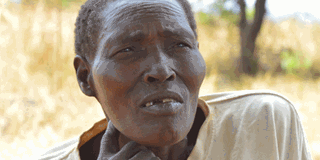Prime
Fighting river blindness along fastflowing streams

Tereza Akulu speaks during the interview. (Below) She has developed a patchy skin infection on her legs as a result of living with river blindness for several years. photo by Paul Menya
What you need to know:
River blindness continues to affect several communities in Uganda. In our series on neglected tropical diseases, we explore interventions that are helping to address the problem.
After 17 years of living with river blindness, Tereza Akulu’s wish is to see development of strong drugs that can heal the disease faster. “I have taken medicine for so long. I am only lucky that I sought medical attention in time which helped me retain my eyesight,” she says.
“Government should bring enough drugs for everyone in our area because this disease is causing blindness in many people,” she adds.
Akulu, 65, a mother of five, lives in Lamacha South Village, Awere Sub county, Pader District in northern Uganda.
She was diagnosed with river blindness in 1997 at Lacor Hospital, Gulu District. It was from here that she was referred to Awere Health Centre III, where she continues to get treatment.
When she first developed the disease, she recalls getting a feeling of burning body pain, which was followed by itching and subsequently the disfigurative skin malady that developed on her legs and scalp.
Whenever Akulu runs out of medicine, she has to walk three kilometers to Awere Health Centre III to pick a new dose. But even though she was lucky to be able to access treatment, it did not come without challenges. “When I started treatment in 1997, I developed rashes, although they later disappeared as I continued with the medicine,” she says.
“But I am not happy because the skin disease has not normalised. It has now spread to my scalp and caused grey hair around the affected area,” Akulu explains.
She is grateful though, that treatment is provided for free by government. “It would have been very expensive for me to buy the drugs.”
Like Akulu, 40-year-old Angulleta Lanyero first developed body rash and itching in 2006. She later developed painful lumps around her waist and was unable to see clearly. She went to Lacor Hospital.
“Doctors at the hospital discovered that I had worms in my eyes. They told me I had contracted river blindness. But I was not convinced that I could have got this disease, so I went to Gulu Hospital, which also confirmed the same.
It is then that I started treatment,” Lanyero says. “The doctors told me the extent of the damage in my eyes will neither increase nor improve because the nerves were damaged. They said I am going to live like this forever. My only problem is the eyes. I continue to see worms in my vision. I have a blurred vision. I cannot see distant objects,” she says.
Inadequate drugs
However, Lanyero decries the inadequate supply of the medicines.
Asked if she would be willing to shift to another place that is not affected by river blindness, Lanyero says she has nowhere to go.
“Besides, where would I get the money to buy land? This is the place where I will be buried.” Many people who have been affected or infected by river blindness also have to contend with stigma in the community.
“This arises from some people who believe that the disease is contagious. They fear interacting with us during social gatherings and sharing food and drinks,” Akulu observes.
River blindness, also known as onchocerciasis, is an eye and skin infection caused by a worm (filaria) known scientifically as Onchocerca volvulus. According to the World Health Organisation, river blindness is transmitted to humans through the bite of a black fly (Simulium species).
These flies breed in fast-flowing streams and rivers in the inter-tropical zones, increasing the risk of blindness to individuals living nearby, hence the commonly known name, river blindness.
Within the human body, the adult female worm (macrofilaria) produces thousands of baby or larval worms (microfilariae), which migrate in the skin and the eye.
The death of microfilariae is very toxic to the skin and the eyes, producing terrible itching and various lesions. After repeated years of exposure, these lesions may lead to irreversible blindness, according to WHO. Tom Lakwo, the manager in charge of the Onchocerciasis programme in the Ministry of Health, notes that the patchy skin condition presents in those who have lived long with the disease.
“This condition is not reversible even when you take medication, and this is common in older people.”
According to WHO, about 90 per cent of the disease occurs in Africa. The latest figures from the Ministry of Health indicate that more than two million people are infected with the parasite that causes river blindness.Most cases have been reported in the western axis of the country bordering the Democratic Republic of Congo and in areas around Mt Elgon in eastern Uganda.
Leading cause of blindness
According to the health ministry, river blindness is a leading cause of blindness and visual impairment in Uganda.
In 2007, the National Onchocerciasis Control Programme (NOCP) launched an elimination plan. The programme is currently being run in 31 districts with the prevalence of the disease through Mass Drug Administration (MDA), supplemented by vector elimination in some feasible areas. Bi-annual and annual treatment programmes are being undertaken in 14 and 17 districts respectively.
To address the shortage of drugs, Lakwo says: “The National Onchocerciasis Control Programme always makes application for drugs based on population figures provided by the district. And it is this information that is then used to deliver supplies.” Lakwo says the Neglected Tropical Diseases Programme has conducted fresh registration in all districts to obtain accurate numbers of people who may be infected. This would be used to minimise cases of drug shortages.
The health ministry says with a good prevention and disease management plan, river blindness can be reduced to a level where it is no longer a public health threat, as long as individuals living in the affected areas receive treatment every year for a period of 15 to 20 years.
“In some areas, where the programme treats all people twice a year, river blindness can be eliminated in less than seven years. With additional blackfly control, it can take fewer years,” the ministry adds.




